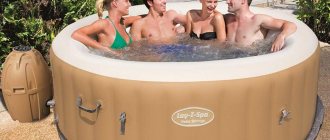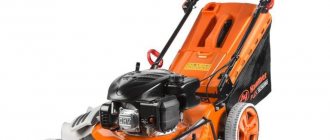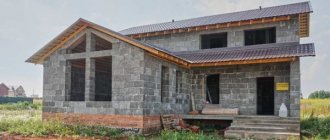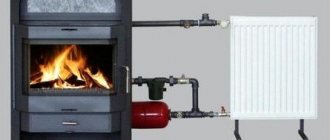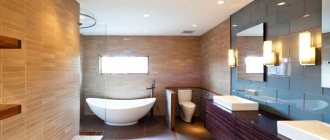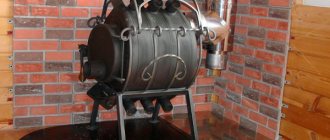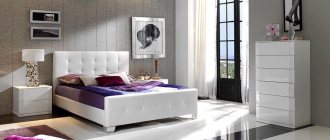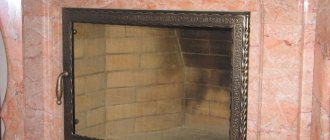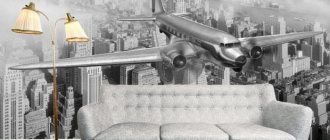The option of purchasing a solid fuel boiler for autonomous heating of premises often becomes one of the best options due to its simplicity and reliability.
However, choosing a unit is a non-trivial process. To make your task easier, we have compiled a rating of the best solid fuel boilers with a water circuit.
When selecting models, we took into account the opinions of experts and installation specialists, user reviews and technical characteristics of the devices.
Here you will find only the best models in terms of price/quality ratio.
Rating of the TOP 15 best solid fuel boilers with a water circuit in 2021
| Place | Name | Price |
| TOP 4 best solid fuel boilers with a water circuit in price/quality ratio for 2021 | ||
| 1 | Teplodar Cooper Praktik 8 single-circuit | Find out the price |
| 2 | ZOTA Yenisei 14 14 kW single-circuit | Find out the price |
| 3 | Lemax Forward-16 17 kW single-circuit | Find out the price |
| 4 | Teplodar Uyut-10 10 kW single-circuit | Find out the price |
| TOP 4 best solid fuel boilers with a water circuit and electric heating element | ||
| 1 | Teplodar Kupper Praktik 14 14 kW single-circuit | Find out the price |
| 2 | Teplodar Kupper OK 15 15 kW single-circuit | Find out the price |
| 3 | Teplodar Kupper Expert-15 single-circuit | Find out the price |
| 4 | Teplodar Kupper OVK 18 18 kW single-circuit | Find out the price |
| TOP 4 best cast iron solid fuel boilers with a water circuit | ||
| 1 | Krontif Siberia 60 single-circuit | Find out the price |
| 2 | Kentatsu MAX-04 38 kW single-circuit | Find out the price |
| 3 | Sime SOLIDA EV 6 56 kW single-circuit | Find out the price |
| 4 | Krontif Siberia 30 single-circuit | Find out the price |
| TOP 3 best solid fuel boilers with a water circuit using wood | ||
| 1 | ZOTA Box 8 8 kW single circuit | Find out the price |
| 2 | Teplodar Kupper OK 9 9 kW single-circuit | Find out the price |
| 3 | Lemax Forward-12.5 13 kW single-circuit | Find out the price |
Design
Solid fuel boilers have a simple operating principle. The combustion chamber is placed in a steel casing; fuel is loaded through the door on the front side of the boiler and ignited.
During fuel combustion, hot flue gases wash a heat exchanger, made in the form of pipes or a water jacket, and transfer heat to the water of the heating circuit. When heated, the water begins to move naturally along the circuit due to the temperature difference at the inlet and outlet of the boiler.
Cooled boiler gases are carried away into the atmosphere through the chimney, also due to the temperature difference at the inlet and outlet of the boiler. Under the firebox there is an ash pan, which is designed to collect unburned parts of the fuel.
The ash chamber door acts as a damper to regulate the air supply to the combustion zone to ensure complete combustion.
How to choose a solid fuel boiler?
The choice of a solid fuel boiler should be accompanied by taking into account the following points:
:
- The heating area is the main characteristic when choosing a boiler unit, usually at the rate of 1 kW per 1 sq.m., however, it is better to take into account not the area, but the volume of the room.
- Types of fuel - not all modern models, like the good old stoves, are omnivorous in terms of fuel. Some options are also very sensitive to it and will not only not provide the specified characteristics, but will also create problems in operation, or even fail altogether.
- Energy independence - of course, most solid fuel boilers are independent of electricity, but pellet options are equipped with electronics that require uninterrupted power.
Wood-burning boiler with water circuit
Monitoring and control systems
Solid fuel heating boilers for private homes are equipped with systems for regulating the water temperature in the water circuit.
A fairly simple thermostat is connected to a lever to which a metal chain is attached. The second end of this chain is attached to the blower flap. When the optimal temperature is reached, the thermostat turns the lever and closes the damper. The air flow is reduced and the combustion process is suppressed until the water cools down to the control system's return temperature. Mechanical air supply control is primitive, but reliable. Remote Control
More sophisticated control systems include electrified forced air supply and more accurate temperature sensors. A low-power electric fan (up to 35 W) built into the air duct system can supply increased air flow not only from below.
The air supply from above creates an artificial “active smoldering” effect in the flame, which allows fuel to be burned much more thoroughly. Such boilers require connection to power supply systems and, in the absence of electricity, become more helpless than their mechanical “brothers”. But fuel savings of 10-15% allow us to say that such systems justify the installation of forced ventilation.
The boiler is not only an independent unit, but also part of the heating system of a private home. Therefore, the power of the equipment must correspond to the volume and circulation pattern of the coolant in the system. If the system is built taking into account forced circulation of water and the rate of heating of the premises is controlled together with the process of fuel combustion in the boiler, the efficiency of the system increases. A thermos tank will help maintain a high water temperature when the boiler goes out.
The base for the equipment must be made of concrete; a sheet of metal with an area of at least 1 sq.m. must be laid on the floor under the ash chamber. The distance to the walls of the room should be at least 30 cm, especially if they are wooden. It is best to make an isolated room in the basement or first floor of the house (mini-boiler room) with a supply of firewood.
Causes of failures during system operation
During the operation of a homemade boiler, certain difficulties may arise. This is not necessarily due to errors made during installation work. The most common problems are:
- Condensate is leaking from the unit. The reason is the low return temperature. To eliminate this, you will need to ensure that the temperature does not drop below 60 degrees.
- The boiler is overheating. The reasons for this are varied:
- generation of excess heat - occurs when the device regenerates additional energy over a small area, water boils, and unnecessary heat escapes through the safety valve;
- stopping the circulation pump: when the pump is de-energized, the cyclicity of the heat supply is stopped. The system boils, releasing excess heat through the protection valve.
Reference. To protect the device with a heating circuit from overheating, you will need to purchase a storage tank and an uninterruptible power supply.
- Smoke leaks through the doors. The chimney must be cleaned.
- Water is leaking from the chimney opening. You'll have to insulate the hood.
- Excessive fuel consumption. The room is poorly insulated, low efficiency of combustible materials.
Review of manufacturers
The complexity of making a wood-burning boiler yourself should not be exaggerated. But still, in general, samples assembled at factories under the guidance of experienced engineers prove to be more reliable and stable. It is, of course, impossible to disassemble all the models that appear in the ratings of the best heating equipment.
But it is extremely important to read reviews about the relatively cheap and most popular versions of boilers
NMK "Sibir-Gefest KVO 20 TE" is designed to supply hot water only to the heating circuit and is capable of generating 20 kW of thermal energy per hour. The equipment of this model is completely independent of electricity, because it is controlled by a mechanical system. Using an open combustion chamber with an efficiency of 80%, it is possible to heat up to 200 m2. In addition to the wood firebox, a 4000 W heating element is provided.
Another very attractive version is the Kiturami KF-35A double-circuit boiler. This device is also equipped with an open firebox and provides power up to 24 kW. Its efficiency is 5% higher than that of Sibir. The connecting dimensions of the chimney are the same. The Korean manufacturer provides an official guarantee of 24 months. The load can contain up to 40 kg of wood, the burning time reaches 5-6 hours. It is allowed to lay firewood up to 0.85 m long.
Features of operation of such boilers
- low price (every homeowner can afford it)
- long service life
- reliability (if used correctly there is simply nothing to break)
- availability and low cost of fuel
- do-it-yourself setup and maintenance (does not require high qualifications)
- relatively low efficiency (compared to gas or diesel boilers)
- periodic loading of firewood is required (once every 3-8 hours)
As you can see, such boilers have both their pros and cons. However, the fact that they are ubiquitous in our country suggests that the use of such equipment for heating a house in winter is very effective.
Boiler design
- So, any boiler you can buy consists of:
- combustion chamber
- grate
- chambers for collecting combustion products (ash chamber)
- heat exchanger (water circuit)
The combustion chamber is the heart of a wood-burning boiler, or fireplace. Wood combustion occurs in it and heat is released. Volatile combustion products enter the combustion chamber into the chimney, which leads them outside. The air required for combustion enters the combustion chamber through the lower ash pan (ash pan), or through adjustable blinds in the combustion door. The combustion chamber is also equipped with a door for loading fuel. It can be made both from the materials of the boiler body and from glass, such as, for example, near a fireplace.
At the bottom of the combustion chamber there is a grate. Through it, the coals and ash remaining from the combustion of wood enter the chamber for collecting solid combustion products.
The ash chamber is equipped with a door, which is used to clean it from unburned residues and to regulate the intensity of combustion by increasing or decreasing the flow of fresh air into the lower part of the combustion chamber. You can do this with your own hands or with the help of a special mechanical thermostat that regulates the flow of fresh air into the combustion chamber depending on the achievement of the specified fluid temperature in the water circuit.
The heat exchanger can be a water circuit, which is like a second body of the combustion chamber. In this embodiment, the liquid heated by the boiler circulates around the firebox, isolating it from the outer casing of the wood-burning heating boiler. Such a heat exchanger is very effective in terms of quickly warming up the liquid and reducing unnecessary heat losses, but if it is damaged for any reason, repairing this circuit can be very difficult.
Also, a system of pipes passing through the internal space of the boiler in the places of the most efficient heat transfer from the combustion chamber can be used as a heat exchanger. Such a system is more convenient to repair than a continuous water jacket system, because each pipe, or the entire pipe system, can be easily pulled out and replaced with a serviceable one.
Boiler interior
The combustion chamber, a system of heat exchangers, is insulated from the outer casing with non-combustible materials with a low thermal conductivity coefficient. This could be asbestos, mineral wool, fireclay clay, ceramic filler, etc. materials.
Such thermal insulation has two goals: - firstly, by reducing the heat transfer of the boiler body into the surrounding space, the efficiency of the boiler itself significantly increases, in terms of the efficiency of heating the working fluid; - secondly, the operating safety of the boiler itself increases when it is installed in a room with fire-prone building materials.
Some nuances in the operation of double-circuit solid fuel boilers
An obvious advantage that solid fuel boilers of this type have is long-term operation with a single fuel load.
For example: 30-50 kg. Firewood placed in the firebox can burn for up to 12 hours. During this time, the unit is able to provide the maximum possible heat to heat living spaces in the house and provide normal domestic needs for hot water. Reducing the consumption of hot water will increase the duration of fuel combustion to 24 hours. The boiler will operate in nominal mode, maintaining a certain temperature in the house.
Something to remember! A solid fuel unit that goes out for a long period during winter can cause the entire heating system to freeze. To avoid such troubles, you can use antifreeze for the main heating circuit.
An important fact is that long-burning double-circuit boilers do not allow high-precision regulation of the temperature of the coolant in the heating system. The reason for the difficulty lies in the inertia of the operating heating equipment. A built-in boiler will solve this problem by creating optimal conditions for controlling the heating unit.
In conclusion, a few words should be said about where and how it is best to install this heating equipment in the house. Heating equipment that runs on solid fuel is available only in a floor-standing version. Due to the bulkiness of the structure itself and the need to install a storage tank, the best option would be to equip a special boiler room.
Tips for use
Like a simple stove, a wood-burning boiler must be operated according to strictly defined rules. Although some manufacturers allow raw wood to be loaded, thoroughly dried wood is still preferable. It increases not only the efficiency of the device, but also its overall service life. During use, you need to carefully monitor the condition of even seemingly minor structural parts. At the very beginning, very small firewood is laid.
Under the firewood they lay out paper, shavings, dried moss or tree bark, then small twigs. You cannot stack firewood very tightly, because if there are no gaps between them, the operating mode of the device will be disrupted. When there are no branches, chips or paper, you can light a wood-burning boiler with pine paws. Ignition with any liquids of natural or industrial origin or gas is strictly prohibited. The pyrolysis chamber is cleared of combustion products before any new kindling.
Noise in the chimney, accompanied by the appearance of a white fire in the firebox, indicates excessive draft intensity. But red tongues appear if the supply of oxygen is unreasonably low. The best and most stable mode is when the wood burns yellow.
In the next video you will find a review of a 12-hour long-burning wood burning boiler.
DIY welding
The materials for making the device are quite affordable, and the tools required for the job are easy to find. The home handyman will need certain skills as a welder and plumber.
You will need:
- Metal container (ordinary barrel, without signs of corrosion). The housing of the unit must be made completely sealed. If there are flaws, they are brewed by filling them with water. The slightest leak is excluded.
Photo 2. Metal barrel, which is suitable for making a wood-burning boiler. Before work, you need to remove the paint from it.
- Thick sheet metal for welding heat exchangers. It is possible to replace homemade radiators with used cast iron batteries. 5-6 sections are enough for the body. Cast iron serves as a good heat conductor, maintaining the required temperature for a long time.
- Profile pipes for the chimney, installation of the frame.
- Doors, gate valves, grates. If the house is large, you will need a circular pump, since the coolant will not rise up through the pipes. There is a reality of defrosting the system during cold periods. Experts advise purchasing a thermometer and a pressure gauge for the mounted device.
- To separate the pipes, you will need to install metal-plastic fittings and cast iron radiators, since solid fuel units with contour heating will not be able to function normally without this.
How to assemble a device using a homemade method
One of the main installation tools will be a welding machine. If you have no work experience, further work is dangerous.
Boiler assembly algorithm:
- Create (at least schematically) a drawing of the future assembly of the boiler and heating circuit.
- Assemble the base that will support the unit. Profile pipes or metal corners are used. It is proposed to design the upper part of the apparatus in an arched shape, which will allow the barrel to take a more stable position.
- Prepare the barrel. Make holes for the combustion chamber and ash, for the chimney, as well as the inlet and outlet openings.
- The tank is installed at the back of the firebox. One of the features of wood-burning boilers is that the exhaust gases envelop the unit, helping to heat the heat exchanger. The installation of the device is done strictly vertically, the fittings are first brought to the holes made.
- They install a metal chimney pipe and prepare the lid and door. The chimney is led out into a common ventilation hole. If there is no ventilation, the pipe is led to the roof.
Next, it is recommended to test the homemade circuit unit. You will need some fuel, which is placed in the combustion chamber and set on fire. If there is no leakage of exhaust gases, proceed to install pipe distribution in all rooms.
Adviсe:
- during installation, carefully consider the correct choice of circuit: the presence of one pipe creates uneven heating, two pipes - makes it possible to regulate the temperature when installing Mayevsky taps at the ends of the radiators;
- connect the fittings and batteries in series;
- Place the expansion tank on the supply line.
After diagnostics, we inspect the structure, eliminate deficiencies, and start the heating process.
Possible difficulties during assembly
It is important to know that a homemade solid fuel device belongs to a risk zone and is included in the group of high-risk structures. Possible problems with incorrect assembly:
A mismatch in the diameter of the chimney pipe leads to poor draft and a decrease in the temperature in the system. Boiler doors are most often not airtight, due to which there is a possibility of smoke leaking into the combustion chamber and there is a risk of carbon monoxide poisoning. Installation of the device without safety devices. This refers to the explosion valve for releasing air and the expansion tank. Formation of condensation in the chimney due to improper assembly of the system
With a horizontal section of the chimney, it is important to install a revision (special cover), which must be regularly cleaned of soot in order to protect the room from fire
Advantages and disadvantages of long-burning solid fuel boilers
Before you begin to study the design of a solid fuel boiler used for heating a private home, you need to familiarize yourself with the advantages and disadvantages inherent in this type of heating equipment.
The advantages of long-burning boilers operating on solid fuel are:
- environmental Safety;
- high heat transfer rates, amounting to up to 90% of the generated thermal energy;
- ease of installation and maintenance;
- the possibility of using different types of solid fuel and its relatively low cost;
- versatility - can be used for heating and hot water supply;
- compactness;
- long combustion periods that do not require frequent loading of burned fuel;
- the ability to operate in automatic mode without the constant presence of maintenance personnel.
Solid fuel boilers operate on different types of fuel - wood and coal, wood pellets and peat briquettes
The disadvantages include the following:
- fuel used in long-burning boilers must meet the requirements for it (humidity, quality, etc.);
- Safety precautions when using solid fuel boilers must be observed at all stages of the work performed: storage and preparation of fuel, combustion and waste disposal;
- the complexity of loading fuel if the boilers are not equipped with automatic systems for this process;
- the cost of boilers of this group is slightly higher than that of short-burning analogues;
- for boilers equipped with an automation system - dependence on the availability of electricity supply and the need for large premises used for fuel storage.
Solid fuel boilers vary in design, technical characteristics and sizes
Smolder and heat: features of using long-burning wood-fired boilers for the home. In a special publication on our portal we will talk in detail about long-burning wood-burning boilers. You will learn the types of boilers and operating principles, the basic requirements for a heating system with a wood-burning boiler, and become familiar with calculating the power of a wood-burning boiler.
Which company should you choose?
Solid fuel boilers equipped with a water circuit are produced by various manufacturers, among which stand out:
- Teplodar is a Russian company with patented technologies that supplies high-quality heating equipment throughout the world.
- Zota is a Krasnoyarsk brand that supplies inexpensive components and boilers of low cost and high build quality.
- Stropuva is a young Lithuanian company that has patented a candle-type long-term combustion technology. It produces models taking into account the climatic characteristics of countries and regions.
Internal structure and difference from other types
Features of pellet equipment are the ability to work autonomously and high efficiency. Inside, the design has 3 main components:
- Furnace. This part contains the burner. It is equipped with control and cleaning doors. The same metal is used to make the firebox as for the body of the device. Its thickness is 4-6 mm. A cast iron grate is installed in this area.
- Convection. A combined or horizontal heat exchanger is located here. It can be tubular or lamellar. The coolant is heated in this zone.
- Ash pit. Needed to collect combustion products.
Pellet boilers are single- and double-circuit. The fuel bunker is located on the outside of the unit, but there are models with internal containers.
Principle of operation
Boiler units are quite simple in their operating principle, based on the basic laws of physics.
The principle itself includes successive points:
- Loading a suitable type of fuel;
- Ignition of fuel using a burner or other fire source;
- Combustion of fuel, during which heat is released and thermal energy is transferred to the coolant for the heating circuit or hot water supply;
- Exhaust of flue gases into the atmosphere through a chimney by natural or forced circulation;
- Natural or forced circulation of heated coolant through the heating system.
The best long-burning solid fuel boilers
Zota Carbon
The lineup
This domestic series of long-burning solid fuel boilers is represented by models with power from 15 to 60 kW. The equipment is intended for heating residential and industrial buildings. The boiler is single-circuit and has the following coolant parameters: maximum pressure 3 bar; temperature from 65 to 95o C. With optimal settings, efficiency reaches 80%. The boiler is easy to load and has movable grates for ash removal.
Watch the product video
Design features
The boilers are completely energy independent. Control is carried out mechanically. There is protection against overheating of the coolant. A built-in heat exchanger made of high-quality steel is installed. The duration of the combustion process is regulated by changing the flow rate of air entering the combustion chamber.
A chimney with a diameter of 180 mm and pipelines of a 2” circulation circuit are connected to the device from the rear wall.
Fuel used. It is recommended to use coal of fraction 10-50 mm as fuel.
Candle
The lineup
The line of Lithuanian heating equipment Candle includes five long-burning boilers with a power from 18 to 50 kW. They are intended for floor installation in residential or industrial premises. The units are designed to operate autonomously as part of a separate heating system. There is no additional circuit for heating hot water. The device is designed for a pressure of 1.8 bar and a coolant temperature of 90o C.
Watch the product video
Design features
The design of the open-type firebox and automatic air supply adjustment provide for a long combustion mode. The water “jacket” is built into the boiler body. There is automatic protection against overheating. Flue gas outlet pipe 160 mm. The diameter of the circulation circuit fittings is 2”.
Fuel used. Firewood or peat briquettes can be used as fuel.
Stropuva S
The lineup
The line of single-circuit long-burning boilers made in Lithuania includes models with a power of 8, 15, 20, 30 and 40 kW. The buyer can easily choose a suitable unit for heating a private home or small business. The most productive of them is capable of maintaining optimal temperature in a building with an area of up to 300 sq.m. No electrical connection required.
During operation, the combustion zone smoothly shifts in the firebox from top to bottom. Efficiency reaches 91.6%. Maintenance consists of periodically replacing fuel, removing ash and periodically cleaning the gas path, including the chimney.
Watch the product video
Design features
The elongated upward shape of the housing saves usable space during installation. The volumetric firebox allows you to load up to 80 kg of fuel. Precise adjustment of the incoming air extends the burning time of one bookmark to 31 hours. The coolant is heated to 70°C and circulates at a pressure of up to 2 bar. On the rear side there are fittings for connecting a chimney with a diameter of 200 mm and heating water 1 ¼”.
Fuel used. The boiler is designed to use dry wood as the main source of energy.

